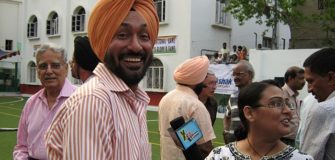Mail Today: Some hearts still beat for hockey here
Share
Some hearts still beat for hockey here
TODAY, the success of a sport seems to lie in attractive packaging and razzmatazz, as the Indian Premier League ( IPL) has shown. Even investors turn their backs on sports that are not glamorous enough. At least, that’s the case with Indian hockey.
But a few dedicated people are burning midnight oil off the field to provide a ray of hope to Indian hockey followers, even as the Indian team leaves for Malaysia to defend the Sultan Azlan Shah Cup, which begins on May 5. Several hockey enthusiasts, including renowned coach Ajay Kumar Bansal, are doing research on various aspects of the beautiful game. From the tribal players of Chota Nagpur in Jharkhand to the bio- mechanics of drag flick, the scope of the research work is vast, varied and fascinating. In Aligarh Muslim University ( AMU) alone, four students are currently involved in research on hockey, says Prof.
Ikram Hussain, chairman, Deptt. of Physical Health and Sports Education.
Dronacharya Award winner Bansal, under whose guidance various Indian teams have won several titles, is just days away from completing his Ph. D. on the tribal players of Chota Nagpur, an area that has produce some of the best known players — from Jaipal Singh Munda, captain of the team that won the first Olympic gold in 1928, to Dilip Tirkey, an ex- India captain and a solid defender. In between, players like Michael Kindo and Manohar Topno emerged from this belt to become household names.
Bansal’s love affair with the tribal players began during his posting in Sundargarh. “ I spent five years, from 1987 to 1992, there as a Sports Authority of India coach. They played without proper infrastructure then,” Bansal told M AIL T ODAY . “ I will soon submit my theses to Prof. Popinder Singh Kullar — brother of former India player Col. Balbir Singh — under whom I’ve done the research,” he says.
Popinder is glad that people are doing research on a game that has now gone downhill. He comes from Sansarpur village that has produced many outstanding players. Little surprise then that his own research was titled ‘ Social cultural and educational ethos of sports: A case study of Sansarpur village in Punjab’. “ Sansarpur has produced 14 Olympians, 19 internationals who represented India and other countries, 110 nationallevel players who turned out for 20 states, and another 132 who represented various military teams,” says the professor with the Deptt. of Education, Jamia Millia Islamia in New Delhi.
In the quiet environs of Aligarh, the four students are earnestly engrossed in exploring different angles of the game, hoping that their work would one day help the game. AMU itself has produced the likes of wizard Dhayan Chand and Zafar Iqbal.
Saleem Ahmad, a research fellow at AMU, is working on the drag flick that was made popular in India by Jugraj Singh and then by Sandeep Singh. Ahmad is currently collecting data for his work titled ‘ Bio- mechanical analysis of drag flick in field hockey’. “ I want to explore which technique is best suited for drag flick,” he said. “ I have received immense encouragment from coach Clarence Lobo. Once complete, I plan to give copies of my work to coaches to help the game.”


